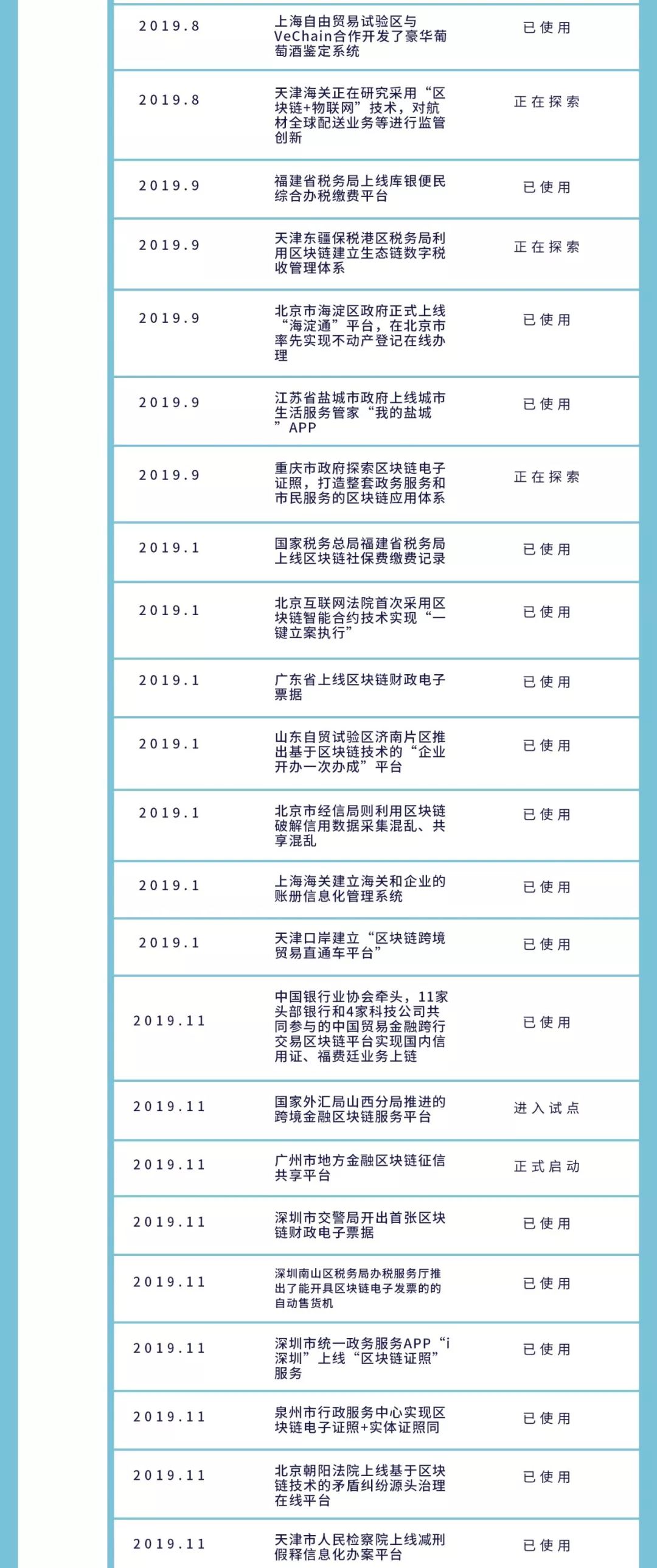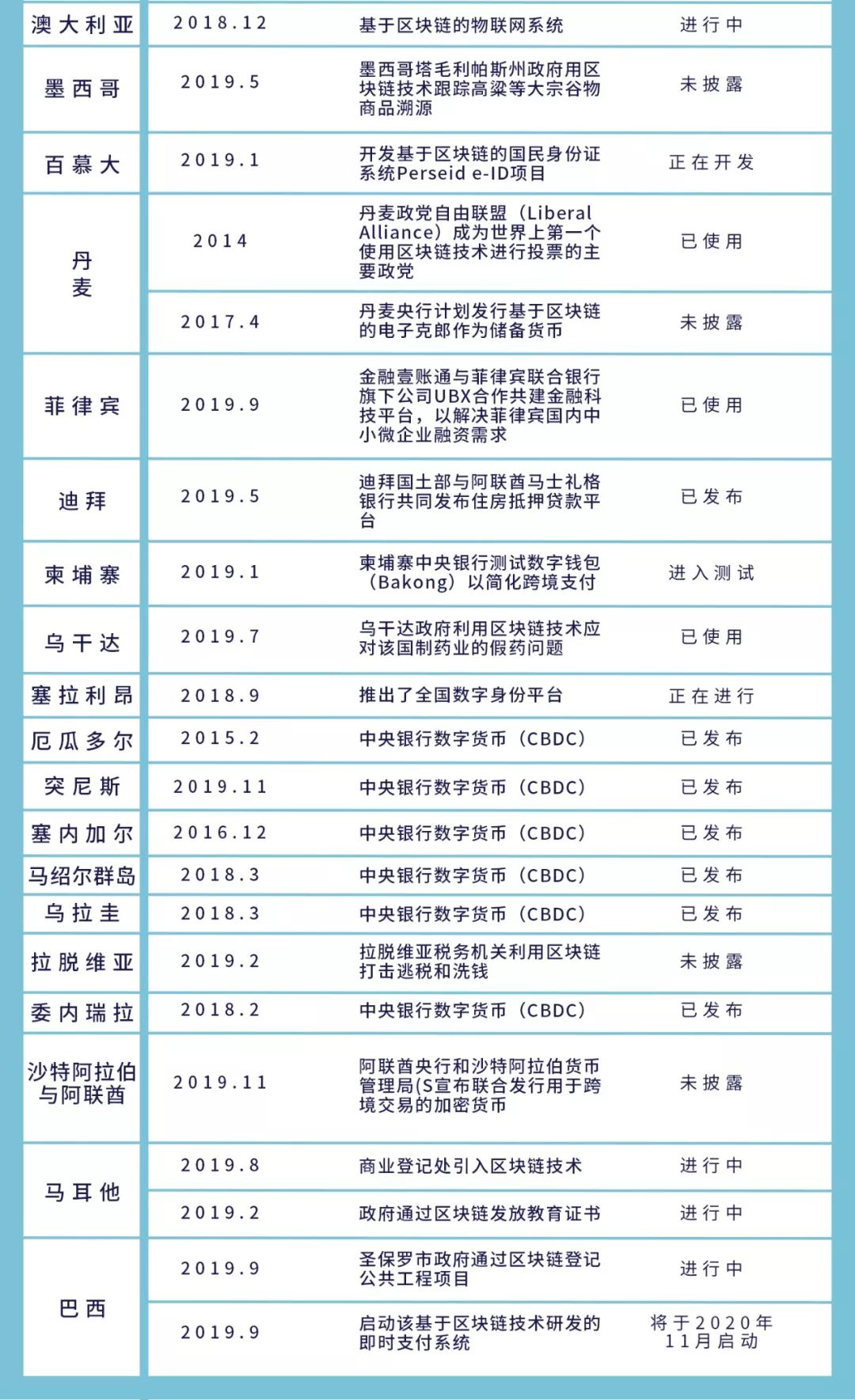Global government blockchain wrestling: digital currency is a fortress, China and South Korea lead government projects
Author: Zhao Xuejiao
Source: Zinc Link
Governments around the world are increasingly feeling the impact of the blockchain technology on the traditional economy, and they have raised the blockchain to the height of national strategy and accelerated the application of the blockchain.
According to Bloomberg data, as of August 2019, the number of blockchain projects promoted by countries around the world has reached 154, which are mainly used in the fields of finance, government archives, digital asset management, and voting.
- 40 banks apply for cryptocurrency custody service licenses, can Germany become the country of choice for the crypto industry?
- Fighting the new crown, the blockchain is late: Blockchain anti-epidemic application report
- What are the top areas in Asia's top blockchain venture capital? Not DeFi anyway
Governments of different countries use blockchain for different purposes, such as saving administrative expenses, anti-corruption, or carrying out unified digital reforms on old administrative systems to improve efficiency.
Zinc Link has consulted the official information release channels at home and abroad, and sorted out the application forms of government blockchains around the world.
There are 127 projects in total, covering more than ten fields including finance, government affairs, digital identity, justice, taxation, voting, commercial services, electronic bills, military, energy, and industrial Internet.






Central bank digital currency, "fortress" of government blockchain
The financial sector is the hottest area in which the blockchain has landed, and the central bank's digital currency is the focus of many governments' active deployment. Because banks in various countries realize that blockchain and digital currencies will soon play a role in the global currency system.
The People's Bank of China announced in July 2019 that it plans to launch a central bank digital currency, which has now undergone closed-loop testing.
On January 23, 2020, six central banks in Canada, the United Kingdom, Japan, the European Union, Sweden and Switzerland announced that they would collaborate on digital currency research.
The Federal Reserve's attitude towards digital currencies has changed from previous prudence to experimentation and exploration. On February 5th, Lael Brainard, the Fed's governor, said that the Fed is studying a series of issues related to digital payments and digital currencies, including policies, design and legal development around the issue of digital currencies.
Earlier in October 2019, IBM and the International Monetary and Financial Institutions Forum released a report that currently 73% of central banks worldwide have expressed support for central bank digital currencies, and 38% of central banks have stated that they are actively exploring and testing this technology.
At present, there are six countries that have officially launched fiat digital currencies around the world. They are all third world countries, including Ecuador, Tunisia, Senegal, the Marshall Islands, Venezuela, and Uruguay.
For third world countries, the main purpose of CBDC is financial inclusion, reducing bank costs, and breaking sanctions.

The most intensive government applications
At present, government affairs are the most widely used scenarios for governments in various regions. China and South Korea lead in the number of landing projects in the government blockchain.
The Chinese government's application of blockchain in the field of government affairs focuses on the digital transformation of government services, judicial, taxation, commercial services, electronic bills, and digital identity.
Although China's government blockchain began to be tried locally in 2017, it is still small in scale. The obstacle to development is that China's government e-government is still lagging behind. The "2018 United Nations E-Government Survey Report" shows that China's e-government development index EGDI is 0.6811, ranking 65th in the world, and there is still a large gap from the leading countries.
The application space of government blockchain is still very broad, and it is still the window period for government affairs layout. As the Chinese government will continue to increase investment, it is expected that large-scale landings will occur in the next few years.
Most blockchain applications in South Korea are also in the field of government affairs. Several government departments, including the National Police, the Rural Development Administration, and the Ministry of Health and Welfare, have used blockchain technology to implement business data upload and process management.
Germany and Japan use blockchain to solve corresponding problems according to their own characteristics.
After official document management and online voting, in February 2019, Fukuoka and Ibaraki in Japan conducted verification experiments including digital product coupons and disaster prevention.
In addition to finance, the German government focuses on exploring blockchain applications in areas such as digital identity, energy and industrial Internet. This stems from the deep industrial background of the German state.
The US government's blockchain technology focuses on four areas: citizen services, regulatory compliance, identity management, and contract management. For example, in January 2017, the US Food and Drug Administration (FDA) explored the use of blockchain to securely share patient data.
Australia announced a national blockchain map strategy in March 2019, focusing on policy areas, including regulation, skills and capacity building, as well as innovation, investment, international competitiveness and cooperation.
In addition, the United States and Australia have repeatedly deployed blockchain technology in the military field.
As early as September 2016, the US Defense Advanced Research Projects Agency (DARPA) established a blockchain-based data integrity monitoring system. In January 2020, the United States Department of Defense (DoD) created a communications platform for the hyperledger blockchain protocol.
Similar to the United States, the Australian government uses Lockheed Martin, the same weapon equipment supplier as the United States, to integrate the characteristics of blockchain technology into its data systems to address potential threats to networks and weapon operating systems.
In the next few years, the landing of blockchain in digital government will usher in an explosion. The blockchain builds a multi-party trust network through a consensus mechanism, further realizing the deep integration of the Internet and government affairs, optimizing government business processes, and making government affairs open to truly transparent and credible.
We will continue to update Blocking; if you have any questions or suggestions, please contact us!
Was this article helpful?
93 out of 132 found this helpful
Related articles
- "Bitcoin Secret History": Bitcoin Forum Discussion on "Snack Machines"
- Investment management company VanEck: institutions should invest in bitcoin, small allocations will significantly increase ROI
- Sneak Peek, Ethereum 2.0 Deposit Contract Interface Flows Out
- Future decentralized data storage for blockchain
- Analysis: Bitcoin and its value growth logic for bull market entry
- Industry Blockchain Highlights: Central No. 1 File Named Blockchain Central Bank Trade Gold Blockchain Platform Business Volume Exceeds 90 Billion
- Perspectives | Two Sides of Ethereum






